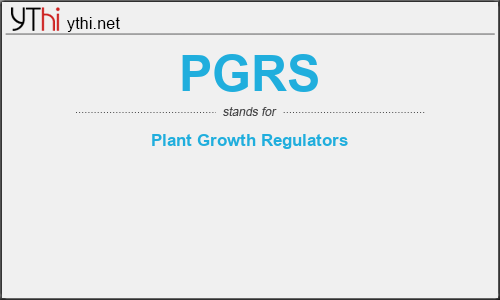What does PGRS mean? What is the full form of PGRS?
The Full Form of PGRS is Plant Growth Regulators.
Plant growth regulators (PGRs) are chemicals used to modify plant growth such as increasing branching, suppressing shoot growth, increasing return bloom, removing excess fruit, or altering fruit maturity. Numerous factors affect PGR performance including how well the chemical is absorbed by the plant, tree vigour and age, dose, timing, cultivar, and weather conditions before, during, and after application.
Plant growth regulators can be grouped into five classes: compounds related to auxins, gibberellins and inhibitors of gibberellin biosynthesis, cytokinins, abscisic acid and compounds affecting the ethylene status. Products that block the biosynthesis of plant hormones are also available (Apogee, Retain)
The five groups of plant growth regulators used in fruit crops include:
Auxins: These are growth promoting substances that contribute to the elongation of shoots, but at high concentrations they can inhibit growth of lateral buds. In addition to being used as plant growth regulators, auxins can also be herbicides (2, 4-D etc.). In apple production napthaleneacetic acid (NAA) is a synthetic auxin that can be used to thin fruit and prevent fruit drop shortly before harvest. For more information on the use of products for thinning see Ontario.ca/apples and find Thinning of Tree Fruit.
Gibberellins: Gibberellins (GA) promote cell elongation, shoot growth, and are involved in regulating dormancy. Promalin®/Perlan® (containing GA4+7 and 6-benzyladenine) have been used to improve fruit size and reduce russetting in apples. ProGibb 40SB and Falgro (containing GA3) are used to delay ripening, improve fruit firmness and extend the harvest period in sweet cherries. Gibberellins are used in tart cherries to manage flowering to avoid over production. Apogee or Kudos 27.5 WDG® (Prohexidione-calcium) inhibits the biosynthesis of gibberellins. Apogee or Kudos 27.5 WDG are used to modify the morphology of trees (apple and cherries) and to control runner production in strawberries.
Cytokinins: Cytokinins promote cell division. Cytokinins are involved in branching and stimulating bud initiation. They are used as fruit thinners (Maxcel® or Cilis Plus® 6-BA) in apples. For more information on the use of these products for thinning see Ontario.ca/apples and find Thinning of Tree Fruit.
Absicisic Acid: Absicsic acid controls the dormancy of buds and seeds, inhibits shoot growth and is involved in regulating water loss from plants.
Ethylene: Ethylene promotes abscission of leaves and fruits, inhibits shoot elongation and inhibits lateral bud development. In apples and cherries, ethylene is involved in the transition of fruit from being physiologically mature to ripe. Ethephon (Ethrel®) is a synthetic compound that releases ethylene upon application. Retain interferes with ethylene biosynthesis and allows fruit to hang on trees longer and lengthens storage life.
PGRS
means
Plant Growth Regulators![]()
Translate Plant Growth Regulators to other language.


Leave a Reply
You must be logged in to post a comment.